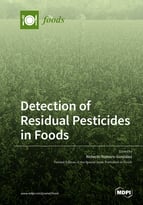Detection of Residual Pesticides in Foods
A special issue of Foods (ISSN 2304-8158). This special issue belongs to the section "Food Engineering and Technology".
Deadline for manuscript submissions: closed (15 December 2020) | Viewed by 37633
Special Issue Editor
Interests: food safety; pesticides; analytical method development; chromatography; mass spectrometry; high-performance liquid chromatography
Special Issues, Collections and Topics in MDPI journals
Special Issue Information
Dear Colleagues,
Pesticides are used worldwide, and despite the fact that organic farming is increasing, they are still widely applied in different countries with pesticide regulations and monitoring programs. This Special Issue will cover the topic of the presence of pesticide residues in food, paying special attention to the use of modern analytical techniques based on chromatographic techniques coupled to mass spectrometry. Extraction methods should be generic in order to allow the detection of pesticides with different physic-chemical properties. Thus, in addition to targeted pesticides, the scope of this analysis can be increased if high-resolution mass spectrometry is used, performing targeted, nontargeted, and unknown analyses, including the detection of metabolites or unexpected pesticides.
Prof. Roberto Romero-González
Guest Editor
Manuscript Submission Information
Manuscripts should be submitted online at www.mdpi.com by registering and logging in to this website. Once you are registered, click here to go to the submission form. Manuscripts can be submitted until the deadline. All submissions that pass pre-check are peer-reviewed. Accepted papers will be published continuously in the journal (as soon as accepted) and will be listed together on the special issue website. Research articles, review articles as well as short communications are invited. For planned papers, a title and short abstract (about 100 words) can be sent to the Editorial Office for announcement on this website.
Submitted manuscripts should not have been published previously, nor be under consideration for publication elsewhere (except conference proceedings papers). All manuscripts are thoroughly refereed through a single-blind peer-review process. A guide for authors and other relevant information for submission of manuscripts is available on the Instructions for Authors page. Foods is an international peer-reviewed open access semimonthly journal published by MDPI.
Please visit the Instructions for Authors page before submitting a manuscript. The Article Processing Charge (APC) for publication in this open access journal is 2900 CHF (Swiss Francs). Submitted papers should be well formatted and use good English. Authors may use MDPI's English editing service prior to publication or during author revisions.
Keywords
- Pesticide residues
- Food
- Legislation
- Generic methods
- Chromatographic techniques
- Mass spectrometry
- Metabolites
- Untargeted analysis







